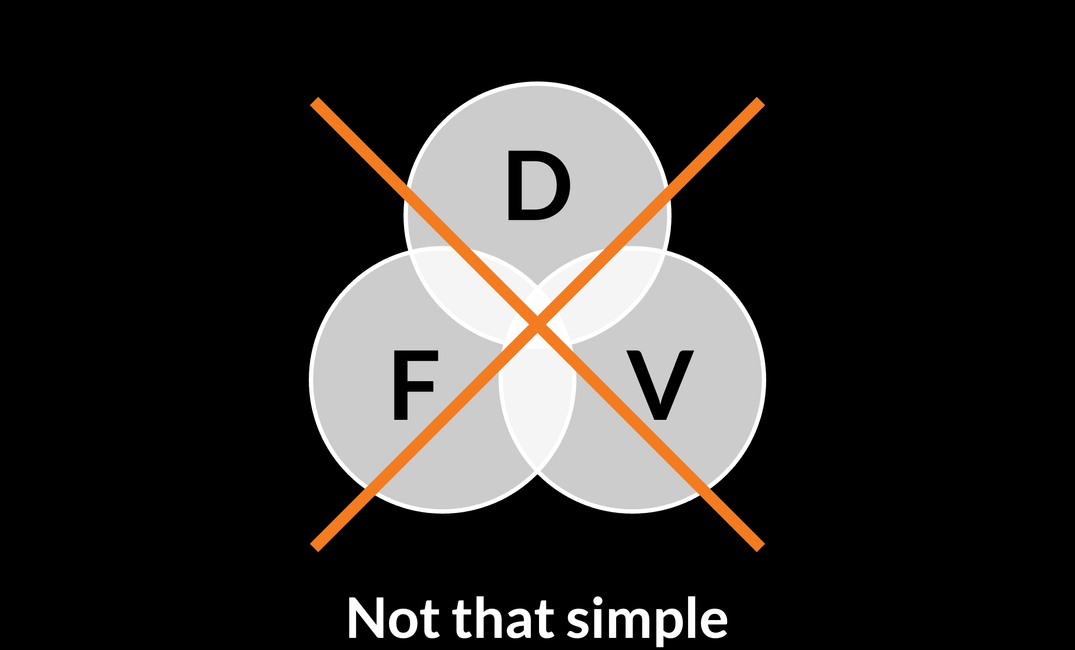You know that when people sell you simple "solve alls," you should be wary.
That's what the innovation mantra of aiming for "desirability, viability, and feasibility (DVF)" has sadly become.
Some worship it as a religion not to be questioned.
Others sell it as a cheap sales lever to hawk quick fix projects that will disappoint you.
Least annoyingly (but also not very helpfully), innovation professionals treat it as a mere organizing principle for simplistically dividing work too early.
To use DVF better, treat it as a long-haul ideal, always to be pursued, never to be reached perfectly, but something at which you can ever better, with many small wins.
(Oh, and if you work inside an existing org, not a startup, also add the "A" of "DVFA.")
Where DVF was helpful
I often read that someone at design and innovation firm IDEO invented the "Desirability, Viability, Feasibility" trifecta. But I have yet to find a trustworthy source. Let's go with it for now though.
Decades ago, and if you are a design firm selling project-based services, this framework was brilliant:
It admonished companies that had gotten so big that they had lost touch with the end users of their products to go out and listen to those users again, ideally with open minds, to create things that actually added value to users, so that, in turn, the company would deserve/ earn the money it charged for its new products or services.
People at those companies had come to think of themselves as "experts" in their space. While likely true, they also often forgot that being an "expert" is not the same as being the user, just like your doctor is not you, the patient. They were not omniscient. To know what was worth creating, they had to remember what their buying public needed.
Sometimes, people at those companies had noticed part of this problem. They had gotten "customer centric," where the "customer" was a B2B intermediary, like a retailer (for CPG companies) or a dealer (for car companies). Those companies listened to their customers, in the hopes of learning what was worth creating. After all, customers were who actually bought their products or services. But this solution often didn't work either. The customers had their own interests, not always aligned with users. They cared about products that might raise their profitability or some other goal. They only indirectly cared about solving users' unsolved problems. Instead, they used various psychological principles to earn more money from things that were not problems. (Thus, for example, the dozens of types of jams at typical U.S. supermarkets. Jam isn't broken.)
Side bar: I'm not saying that earning more money when things are basically fine is easy. I am deeply impressed by trend spotters, scientists, designers, and others, who can wring yet another ounce of newness and other "commercial innovation" out of such mostly-already-optimized spaces. For example, early in my career, I marveled at designers who could create new and better U.S. flag patterns to print on picnic plates to sell for summer holidays. It's just that there was never a "Desirability" problem here.
So far, so good. Listening to your users is generally good.
Where DVF has increasingly run into trouble
I see a variety of issues that turn DVF into a cliché. But they have in common that they all turn it into something that sounds great but doesn't deliver on its promise, leading to disappointment from clients and lesser credibility from innovation efforts.
DVF is hard in startups
In startups, the most common problem is that they never reach all three dimensions of DVF. Turns out, creating a business that checks all the boxes is absurdly hard.
In particular, it tends to be much easier to meet two of these criteria and then to struggle with the third: There are lots of user problems ("D") for which we can find solutions ("F"). But earning money with them ("V") can frustrate people to tears and eventually scuttle their efforts. On the other side of the coin, we can create solutions ("F") that earn profits ("V") but don't help humanity at all. It's just a money-grabbing rehash of old inventions.
It gets worse when interest rates are low and money is cheap for VCs to get. Why not speculate on a few long-shot startups then? That's how we get what is now called "ZIRP" or "zero interest rate phenomena" (or, originally, zero interest rate policy). Without quasi-free money, those ideas would never have happened. But while it lasts, even some of the biggest deca-corns burn billions of dollars annually, in the hope of eventually reaching profitability at massive scale.
DVF is hard in existing orgs too
Professional services organizations and internal innovation teams also try to sell existing companies on the gospel of DVF. But there too, trouble often brews:
Most importantly, DVF lacks any concept of "A" – Agreeability/ Acceptability. It causes teams to create solutions or businesses that make sense to someone somewhere, but not to the company that is sponsoring the effort. It's dead on arrival.
Even if we focus in on just the original and appropriate idea of DVF being a tool to get people to listen to users, it can still cause trouble: Many of the "unmet user needs" that one might uncover are still unmet because meeting them does not fit with the business of the org. The company's operators, marketers, and sales people are not dummies. If there were an obvious opportunity, they may have done something about it. More likely than them totally missing it is that they actually spotted it but concluded that the company would reject a business or solution created to solve that user problem. (No, not always. But often.)
The original intent of adding "D" to create DVF also can blow up on you in another way:
If you manage to get people in your org to value user input, they (and you) might overlook that there are other blockers to successful innovation in your company. Maybe you lack key capabilities, funding for new solution launches, or something else. But no matter what else is going on, "just" building user centricity may not solve your issues. And then, that same user centricity suddenly becomes the easy culprit for all that goes wrong. After all, you suggested it as a solution, people tried it, and still, nothing got better.
And finally, DVF can also tempt innovation teams themselves in dangerous ways. Too often have I seen the three letters as separate functions with separate work. But while we innovate, functions are hazy, overlapping spaces at best. E.g., engineers simply can't create something "Feasible" that should exist without considering what users would find "Desirable." Similarly, marketers can't figure out what might make a "Viable" business without considering the limits and business impacts of creating the solution as part of "Feasibility." In more than one case, projects I have seen blew up over problems with such artificial division of labor.
Sure, certain team members will focus more on D, V, or F. But fundamentally, we split the three concepts at our own peril.
Great, genius. Got anything better?
A better way comes in two forms:
- Treat DVF like a long-term ideal: Aim for it, keep getting better at it. Accept progress in small increments. But respect it as absurdly hard, never to be used glibly.
- Add "A" if you are building new businesses: It should go without saying. You are only set up for success if people will actually agree to accept the innovations you create. If it's not in their interest, they won't. And if you don't consider those interests from the start, your solution is not that likely to suit their needs.
- Pair DVF with another framework: DVF is an incredibly abstract idea. Have we "reached" DVF? Have we not? Debatable on its own. So pair it with something more concrete. It will help you quantify your progress and give people who think more practically than conceptually ways to contribute to progress. For example, I get a lot of mileage out of Ash Maurya's Two Equations, the "Value Equation" and the "Monetization Equation." Fancy names aside, all they say is this: You have to create more value for users than you capture. And then you have to capture more value than it costs you to deliver it, or, all together: "Create Value > Capture Value >= Cost (Deliver Value)".
- Treat DVF as everyone's work: At any given point, the team may focus more on one or the other concept. But if you ever see hard divisions being drawn among them, work hard and fast to make people see their blindspot and to go back to treating the concepts as directional work step priorities, not functions.
Respect your DVF(A). Don't let anyone turn it into a cliché.


